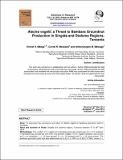| dc.description.abstract | Aims: To document the occurrence and effect of Alectra vogelii on bambara groundnut yield in Tanzania.
Place and Duration of Study: Singida and Dodoma regions, Tanzania between 4th to 20th April 2014.
Methodology: The number of A. vogelii and of bambara groundnut plants per 2 m x 2 m quadrant in triplicates was counted per farm from nine different villages. The A. vogelii infestation was scored as 0 = no infestation, 1 = 1-5 (less severe), 2 = 6 – 10 (severe) and 3 = > 10 (very severe). The bambara groundnut yield loss was determined as (C-A)/ C x 100% or (C-B)/C X 100%, where C = Number of pegs in a non-infested plant, A =Number of pegs in a wilted A. vogelii- infested plants and B = Number of pegs in yellowing or stunted- A. vogelii infested plants
Results: The average number of A. vogelii was 55 plants infesting about 26 plants per quadrant. This number scored 3 (very severe) in a 0-3 scale. The highest number of pegs (90, 75 and 68) per plant was recorded in the non- infected bambara groundnut plants in Iramba, Dodoma urban and Ikungi Districts, respectively, while smaller number or no pegs was recorded in yellowing-A. vogelii infected or wilted-A. vogelii infected plants translating to a yield loss of 97.3–100%.
Conclusion: A. vogelii is a threat to bambara ground nut production in Tanzania. Yield losses of up to 100% have been recorded and this can affect growers who depend on the crop for their protein source. As no report from the literature showing the occurrence of A. vogelii in bambara groundnut in the country, we document its first report and effect on the yield of the crop in Tanzania. Future studies to determine distribution of A. vogelii in other bambara groundnut-growing areas are needed. | en_US |

